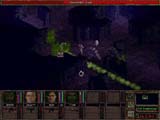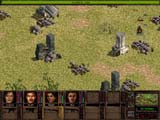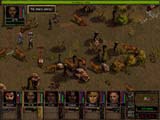 The
opening of any new game always carries with it an inherent excitement.
There is something intoxicating about the feel of a
shrink-wrapped box containing your latest acquisition.
The rectangular bulk of the packaging, the feel of the plastic
beneath your skin, it tickles the senses, tinges the curiosity, and
makes you wonder, “How late is this game going to keep me up
tonight?” It
is the question that ultimately describes the overall quality of a
game, taking into account graphics, game-control, story content and
execution; everything.
Was the game engrossing enough to appeal to me over my bed?
If so, how late did it keep me up?
Was I kept enthralled until the late hours of the night, when
the appeal of my bed was the strongest, and I had to battle to keep my
eyelids open as well as the enemies in the game?
Or did I put it down after only an hour of the soft blankets
calling to me? The
opening of any new game always carries with it an inherent excitement.
There is something intoxicating about the feel of a
shrink-wrapped box containing your latest acquisition.
The rectangular bulk of the packaging, the feel of the plastic
beneath your skin, it tickles the senses, tinges the curiosity, and
makes you wonder, “How late is this game going to keep me up
tonight?” It
is the question that ultimately describes the overall quality of a
game, taking into account graphics, game-control, story content and
execution; everything.
Was the game engrossing enough to appeal to me over my bed?
If so, how late did it keep me up?
Was I kept enthralled until the late hours of the night, when
the appeal of my bed was the strongest, and I had to battle to keep my
eyelids open as well as the enemies in the game?
Or did I put it down after only an hour of the soft blankets
calling to me?
In
the case of Jagged Alliance 2: Unfinished Business, an add-on to
Jagged Alliance 2 from Interplay (though it does not require the original to play), the answer is 4:00 o’clock a.m.
In other words, late. UB
is a combat-orientated game built on the excellent turn-based engine
of Jagged Alliance 2, and though it does lack for both an integrate
story line and modern graphics, it still comes across as a gripping
game with good play and an excellent sense of humor.
 You
begin the game at the point that Jagged Alliance 2 left off.
After successfully managing to rid Arulco of bad people (of
which there were many), you return home only to discover that you are
once again needed. You
are rehired and sent back into the country to take care of remaining
unfinished business. You
begin the game at the point that Jagged Alliance 2 left off.
After successfully managing to rid Arulco of bad people (of
which there were many), you return home only to discover that you are
once again needed. You
are rehired and sent back into the country to take care of remaining
unfinished business.
Unfortunately,
the limited story line is possibly UB’s most significant drawback,
seeming to lack a bit in imagination, which is surprising considering
the creative humor evident throughout the game (Take the M.E.R.C.
webmaster, for example, Will Gates).
The plot progression is also totally linear.
If it weren’t for the mission builder that is included (more
on that later), and the player made maps you can find on the Internet,
there would be little replay value at all.
However, one must wonder how fair it is to demand a detailed
and all-encompassing story line from an add-on, and while it is
somewhat lacking, the plot (or lack of) doesn’t subtract from the
essence of the game: The Combat.
 After
you have been hired, you must build a team of specialized mercenaries.
For this you make use of two competing organizations, both of
which carry a roster of warriors for hire.
After designing your own customized character (for a fee), you
assemble your team from a list of men (and women) with varying skills
and abilities, as well as widely varying prices.
At this point I found it odd that while you were given a wide
variety of services for recruiting mercenaries, you were given no
options at all for purchasing their equipment.
I found myself conserving my money and hiring second rate
mercenaries so that when I arrived at the equipping stage I’d have
adequate funds to buy the really good toys. I kept waiting for that
stage to arrive all they way up until combat began, but it never
appeared. While you do
collect a wide variety of nifty weapons and gadgets throughout the
game, I still felt that the ability to specialize my team before
entering combat would have added something. After
you have been hired, you must build a team of specialized mercenaries.
For this you make use of two competing organizations, both of
which carry a roster of warriors for hire.
After designing your own customized character (for a fee), you
assemble your team from a list of men (and women) with varying skills
and abilities, as well as widely varying prices.
At this point I found it odd that while you were given a wide
variety of services for recruiting mercenaries, you were given no
options at all for purchasing their equipment.
I found myself conserving my money and hiring second rate
mercenaries so that when I arrived at the equipping stage I’d have
adequate funds to buy the really good toys. I kept waiting for that
stage to arrive all they way up until combat began, but it never
appeared. While you do
collect a wide variety of nifty weapons and gadgets throughout the
game, I still felt that the ability to specialize my team before
entering combat would have added something.
When
you have completed assembling your team, you exit the preparation
screen and proceed to the heart of the game, the tactical combat.
This is where the game begins to shine.
Combat is controlled through an aerial perspective in a Fallout
2 meets X-com style turn-based system.
After your team is deposited in hostile territory, you finally
get to the section of the game that keeps you up at night.
The artificial intelligence system and complexity of the combat
are excellent. I found myself being forced to revise my tactics several
times in order to survive, each time to fit a new situation. This is no game of brute strength, in which you rely on sheer
firepower to prevail. Were
you to try you would very quickly find yourself scraping char off your
skin in some level of Dante’s
Inferno. Much as in real
combat, your men are as fragile as your enemies, and they must last
throughout the game, for while it is possible to hire other
mercenaries, they must to cross dangerous territory in order to catch
up. The farther into the
game you go, the more difficult it is to find replacements.
As a consequence you find yourself saving and re-loading a
great deal, trying to conserve the life force of each of your
mercenaries (though there is a setting that disables the save feature
during combat).
 I
found myself spending (and enjoying) hours on each mission, sneaking
up on fringe guards in the night with silencers, sniping men from
rooftops, and flushing out well defended positions with extreme care
and hand grenades. Be
prepared to spend a great deal of time trying to get everything just
right. I
found myself spending (and enjoying) hours on each mission, sneaking
up on fringe guards in the night with silencers, sniping men from
rooftops, and flushing out well defended positions with extreme care
and hand grenades. Be
prepared to spend a great deal of time trying to get everything just
right.
This
game is not for the faint-hearted, by any means. Even on the easiest of settings I found this to be one of the
more challenging games I’ve ever encountered (at least, good games).
I would recommend playing Jagged Alliance 2 before looking at
this one, as the term add-on suggests, even though it does not require
the original to run. UB
refines specific elements of the original, leaving the game play about
95% tactical combat, with little of the resource management that was
included in JA2. If you
are looking for anything more than a tactical combat game, look to JA2
first and should probably consider passing UB up entirely (keeping in
mind though that it has been a long time since a game has kept me up
until 4 in the morning).
 While
the game play experience is gripping, and while I found myself
delaying both sleep and work for the sake of my tiny little
mercenaries, there are two faults that bothered me, one of which
I’ve already mentioned--dated graphics and a completely linear story
line. As for the
graphics, I’m not really a stickler.
I have no problems enjoying a game such as Fallout 2, or Jagged
Alliance 2, or even the (ancient) original X-com, regardless of how
pretty it is as long as the feel of the game isn’t compromised.
In fact, in UB the grit of the images on the screen almost adds
to the game; I have troubles imagining what a sleek outer coating
would look like at all. At
the same time, however, there are times when mildly poor graphics are
a major turn off. A
professionally designed and produced game should not contain graphics
that I, as a slightly above average computer user, feel I could easily
reproduce. Point and
case: UB’s opening screen. Like
the first chapter of a book, which has to catch your attention in
order to keep you reading, the beginning scenes of a game help to
determine the quality of the gamer’s experience all the way until
the end. Interplay’s
revolving planet has always been a good start for me since Fallout 2
(and will be still), but when the screens following it looks as if it
were made with Photoshop’s ‘cloud’ filter, somebody made a
mistake. While
the game play experience is gripping, and while I found myself
delaying both sleep and work for the sake of my tiny little
mercenaries, there are two faults that bothered me, one of which
I’ve already mentioned--dated graphics and a completely linear story
line. As for the
graphics, I’m not really a stickler.
I have no problems enjoying a game such as Fallout 2, or Jagged
Alliance 2, or even the (ancient) original X-com, regardless of how
pretty it is as long as the feel of the game isn’t compromised.
In fact, in UB the grit of the images on the screen almost adds
to the game; I have troubles imagining what a sleek outer coating
would look like at all. At
the same time, however, there are times when mildly poor graphics are
a major turn off. A
professionally designed and produced game should not contain graphics
that I, as a slightly above average computer user, feel I could easily
reproduce. Point and
case: UB’s opening screen. Like
the first chapter of a book, which has to catch your attention in
order to keep you reading, the beginning scenes of a game help to
determine the quality of the gamer’s experience all the way until
the end. Interplay’s
revolving planet has always been a good start for me since Fallout 2
(and will be still), but when the screens following it looks as if it
were made with Photoshop’s ‘cloud’ filter, somebody made a
mistake.
Still,
despite the poor graphics at the beginning, the actual graphics in
combat where it counted seemed to fit the style of the game, outdated
as they may have been. I
was not turned off by the graphics, and in fact didn’t give them a
second thought after I began playing until I started writing this
review.
 As
for the linear story line and lack of replay value, Interplay included
a Scenario editor/builder that ships on the UB CD.
The editor, though not very user-friendly, needlessly
complicated, and riddled with limits (the inability to change the very
first map in the UB scenario, for example), does allow for players to
design their own campaigns for JA2: UB.
I was able to find some very well done player-made scenarios on
the Internet which, if you don’t mind the fact that all the
scenarios start out on the same map, provide different missions than
the ones included with the game.
I was able to find some that I thought to be better developed,
despite limitations of the editor that don’t allow you to narrate
the story or use NPCs, than the UB scenario that is included with the
game. The inability for
players to import their own graphics prevents the player-made
additions from truly feeling like a fresh game with each download,
which seems to me could have been accomplished with a little advanced
thought from the programmers. As
it was I felt the Mission builder was a tool the developers made to
help speed along their own work during production, never really
intending it for the public until late into the release of the add-on.
Come to think of it, that was sort of my impression of the
entire program, that it was pieced together from fragments of Jagged
Alliance 2. The parts that came from the original were engrossing and
fun, well thought out and worked through, such as the combat system.
The sections released for UB were much less so, and it showed. As
for the linear story line and lack of replay value, Interplay included
a Scenario editor/builder that ships on the UB CD.
The editor, though not very user-friendly, needlessly
complicated, and riddled with limits (the inability to change the very
first map in the UB scenario, for example), does allow for players to
design their own campaigns for JA2: UB.
I was able to find some very well done player-made scenarios on
the Internet which, if you don’t mind the fact that all the
scenarios start out on the same map, provide different missions than
the ones included with the game.
I was able to find some that I thought to be better developed,
despite limitations of the editor that don’t allow you to narrate
the story or use NPCs, than the UB scenario that is included with the
game. The inability for
players to import their own graphics prevents the player-made
additions from truly feeling like a fresh game with each download,
which seems to me could have been accomplished with a little advanced
thought from the programmers. As
it was I felt the Mission builder was a tool the developers made to
help speed along their own work during production, never really
intending it for the public until late into the release of the add-on.
Come to think of it, that was sort of my impression of the
entire program, that it was pieced together from fragments of Jagged
Alliance 2. The parts that came from the original were engrossing and
fun, well thought out and worked through, such as the combat system.
The sections released for UB were much less so, and it showed.
Despite
its drawbacks, Jagged Alliance2: Unfinished Business pulls it off
where it matters; the game is fun to play.
Whether or not the game has all the right characteristics unto
itself is questionable, but the fact remains that it inherited enough
from Jagged Alliance 2 to still make it an excellent game.
Though the graphics are a bit dated and the game play won’t
ever be known for its striking originality and diversity, it is still
built on an excellent combat system and retains the power to draw you
deep into its heart. Though
the execution of the ideas were not done as well as they could have
been, the heart of the game was in the right place, and with features
such as the level editor, UB still deserves a good review. And when it all comes down to it, I still didn’t go to bed
until four in the morning, and a game hasn’t kept me up that late
for a very long time.
Aaron
Stanton |
